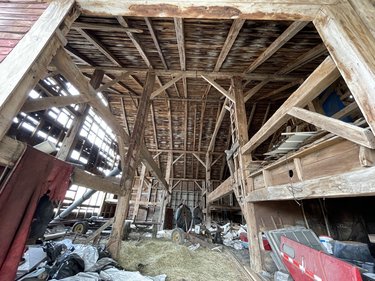Drawing on the past, interpretive center is to be ‘an investment in the future’
— Photo from Mary Liz Stewart
This 18th-Century Dutch barn in Montgomery County, dismantled by Tim Rau, will be reassembled as an assembly hall in the modern Underground Railroad Education Center. Mary Liz Stewart said she “met” Tim Rau through an Enterprise article about him; his grandfather, the late Ev Rau; and the New World Barn Company.
The Underground Railroad Education Center has received another sizable contribution to further the building of a green interpretive center.
Assemblywoman Patricia Fahy announced on Sept. 19 that she has secured $150,000 that will be used to help reconstruct an 18th-Century Dutch barn from Montgomery County within the modern center.
“Standing in the presence of those hand-hewn beams brings to life the hands that took them from their form as majestic trees and turned them into the beautiful architectural structures they became,” Mary Liz Stewart, who founded the Underground Railroad project with her husband, Paul, wrote The Enterprise in January.
“Built in 1764 and used on a farm that was worked by enslaved individuals, the timber frame will frame the main assembly hall in the Interpretive Center,” Stewart went on, noting the timber frame would allow the center “to tangibly speak about the institution of slavery in New York state as well as emancipation and freedom.”
Stewart added, “An additional asset of this timber frame, beyond its historic significance, is the fact that, due to its age, it is free of toxins and carbon, thereby contributing to the zero carbon interpretive center design.”
Altogether, it will cost $400,000 for the timber-frame purchase, storage, cleaning, fumigating, and raising of the Dutch barn inside the new center, according to a release from Fahy’s office.
“The Interpretive Center, which will be located on Livingston Avenue in Albany’s Arbor Hill neighborhood, a community that has suffered extensively from the challenges posed by redlining and disinvestment,” the release said, “will provide job and workforce development opportunities for community residents, draw local, statewide, national, and international visitors, and enhance the community anchor quality of The Stephen and Harriet Myers Residence, and it will be a resilience hub for the community.”
In the 1990s, the Stewarts founded the Underground Railroad History Project, which purchased a brick row house at 194 Livingston Ave. that was the home of Black abolitionists Stephen and Harriet Myers.
Stephen Myers was the editor of The Northern Star and Freeman’s Advocate. “We devote all our time to the care of the oppressed who come among us,” he wrote in 1860.
Largely through grants and volunteer efforts, the Stewarts’ organization saved the venerable brick row house that had been on the verge of collapse. It serves as both a museum and a space for meetings and myriad events.
The interpretive center is to be built next to the Myers house.
The project received two other large grants last year: $2 million through the New York State Capital Assistance Program, and $1,107,457 from the New York State Energy Research and Development Agency.
Paul Stewart told The Enterprise in December 2023 when the project received the NYSERDA grant that the cost of the construction project is expected to be about $10 million, of which $3.4 million had been raised at that point.
“Recognizing that the Interpretive Center is more than a pretty building,” the Stewarts said in a statement on receiving the $150,000, “it will be an asset in terms of its architectural and environmental features, its purpose, and its impact in the community, benefitting the city of Albany, the county of Albany, and New York state. The Interpretive Center is an investment in the future by mobilizing the community’s historic and contemporary resources for positive change.”
Tours and a concert
The center offers tours, open to the public, at the Myers Residence. Tours last about an hour-and-a-half and must be scheduled ahead by calling 518-621-7793. The tours cost $12 for adults with a two-dollar discount for seniors; the cost for youth under age 16 is $6.
To celebrate its 20th anniversary and to raise funds, the Underground Railroad Education Center is holding a concert, Arias in the Afternoon, on Sept. 29, from 11 a.m. to 2 p.m. at the Argus Hotel at 8 Thurlow Terrace in Albany. Fahy is hosting the event.
Daniel Pascoe Aguilar, who has written five musicals and recorded 13 albums, will perform arias from famous operas.
He developed a passion for music in his childhood, performing in diverse churches and with religious and professional groups over the years. Recently, he sang Handel’s Messiah and Orff’s Carmina Burana at Carnegie Hall in New York City, as well as singing at Luiss University in Rome, Italy, and at Santo Tomás University in Santiago, Chile
Aguilar is Excelsior University’s Chief Diversity Officer and is the founding director of the Center for Social Justice, where he is co-leading the inception of a justice, equity, diversity, and inclusion initiative with the goal of helping Excelsior become a multicultural organization.
“Daniel is a wonderful singer,” said Paul Stewart in an announcement about the event. “He has sung around the world and we are fortunate to have him sing for us at this event!”
Tickets, which cost $100 including brunch and champagne, and an extensive online auction may be accessed online at https://undergroundrailroadhistory.org/arias-in-the-afternoon/.



Thank you, Altamont Enterprise, for such a wonderfully written article!